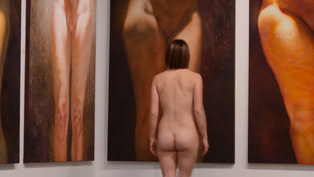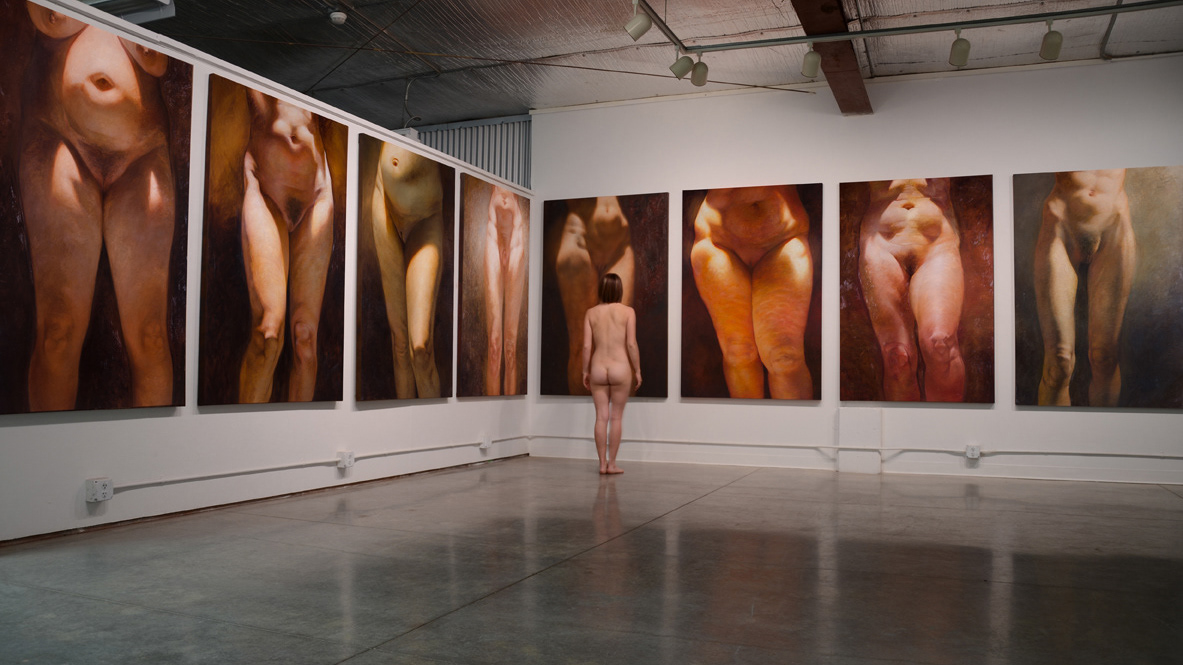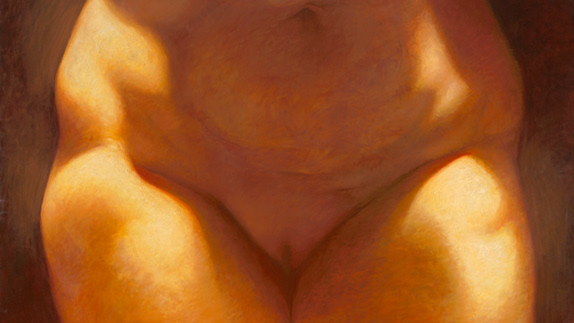A painter's confrontation
When Willem De Kooning said that “flesh was the reason that oil painting was invented” he could well have been referencing treatments as diverse as the polished sheen of Flemish paintings and Bronzino nudes to the sumptuous handling of bountiful flesh by Titian and Rubens. In more recent times the medium has well served the distressed images of naked bodies painted by Lucien Freud, Jenny Saville and De Kooning himself. Francesco Gillia, well aware of all this history, and in overt agreement with De Kooning’s assertion, has returned to the Old Master approach in his bold and imposing series of female nudes in frontal poses.
In this series Gillia challenges orthodoxies of criticism: the rhetoric of the male gaze; the modernist dictum that you don’t excavate the illusion of three dimensional bodies from the flat surface; the social indecency of a forced confrontation with the figures’ genitals, placed right at eye level in installation. These over-life-size bodies glow from the darkness in a range of bodily forms running from youthful, smooth and slim to massive and roiled. The figures are cropped to establish a close proximity to the viewer. Their feet would share the floor with us, but they are absent, as are heads and arms. Abstract slashes of light animate the torsos and thighs, often leaving the mound of Venus shadowed. One must move up close for a full appreciation of the marvels of the flesh in Gillia’s technique, ranging from the scumbles of thick impasto that catch the light as in a Rembrandt to the weavings of layers of multicolored glazes in the shaded areas. The whole series takes on a luminosity and monumentality that evokes the qualities that Gillia admires in his favorite modernist, Mark Rothko.
All this obsessive flesh is presented with strong verticality, a dominating presence far removed from the passivity of the reclining nudes that are the prevailing condition for the female nude in the Western tradition. Much of that flesh is of the abundant kind, replete with bulges, bumps and folds depicted with a candor that engages the viewer and denies idealization. The frontality of pose and emphasis on the uncovered genitals acknowledge human sexuality. What is kept private is made public in the openness of art. The series resounds with the erotics of the studio, where the artist and model confront each other. The variety of body types and the unflinching exposure confirm the consent of the models, but with a tension. In Gillia’s prodigious series the returning gaze of the models is strongly implicated, and the tension this creates is inseparable from our response to the beauty of the bodies.
Harvey Hamburgh
________________________________________________________
Pronaos and the female body through a classical lens
With Pronaos, Franceso Gillia produces a series of fragmented and outsize nudes possessing a compelling, monumentalized presence while successfully navigating through the artistically perilous territory around the historical contruction of his subject in western visual culture: the female body. His avoidance of tired tropes is successful, ultimately, because Gillia avoids the pitfalls of post-modern irony or bloodless service to the classical tradition. The artist enters into a dialog with the classical legacy from an interestingly unexpected direction, through the evocation of monumental sacred spaces and architecture. Whether looking at a single image or experiencing the paintings collectively in regularly spaced intervals along the gallery walls, a shift towards the language of architecture to discuss the work feels both natural and inevitable. The reasons for what I’ll call the “architectonic aesthetic” go well beyond the scale—although the imposing bulk of these figural forms is a significant experiential quality--to include reception. Gillia’s nudes aren’t architectonic because they look like architecture but rather because they share qualities of monumental sacred landscapes belonging to the classical world. They are particularly evocative of the collection of massive archaic Greek temples scattered across the landscape of southern Italy. While our contemporary perception and use of Greek architectural orders is one of quotation to the point of numbed exhaustion in terms of meaningful content, Gillia’s nudes are an invigorating reminder of the earthy physicality and connection to organic form the earliest examples of the Greek Doric temple possessed. Like the colonnades ringing the exterior of the pronaos and the cella, his succession of painted torsos and legs combines the “platonic ideal” or essential nature of a thing (in this case the core of the female human body) with the calculated irregularity that gives life and breath to a human-made form. As originally envisioned, the Greek Doric column was not crisp in profile and contour but swollen as if full of breath, suggesting a living marker of the boundary between sacred and profane. Standing in the gallery space, Gillia’s bodies reference the underlying corporeal qualities of this type of architecture as well as the power columns gain through rhythmic repetition. The resulting experience mediates between the specifics of meticulously observed individual forms and the transcendent organic quality all memorable monumental works possess, ancient and modern.
Gillia focuses on the female subject as delineated only by her torso and upper section of the legs, a compositional choice contributing to the series’ architectonic power. Given his concentration on the portion of the body containing the most explicit markers of biological sex, it is surprising, once more, how deftly he avoids another potentially limiting construction. This one concerns the imaging and reception of the female nude, again with the classical tradition in western visual culture as the touchstone. Defined as they are by nudity and fragmentation, his female bodies should be a neat fit into the category of depersonalized or passive viewed object, shaped in equal measure by the historical male gaze of sexual possession and the formalized connoisseur’s gaze, equally possessive, of museum culture. The earliest large-scale female nudes in the west depicted Venus. The invitation to look at her unclothed form was conventionally extended by a carefully scripted moment: her position of crouching or turning plus the addition of grooming implements are meant to reveal a goddess surprised, fully exposed while caught in the act of bathing. Typically, her own gestures, hands in position ostensively to cover her breasts and groin in modesty but in fact drawing the gaze to those very areas, are a lesson in how the male artist imaged the nude goddess as complicit in, even inviting of, the possessive sexual gaze. Although Venus imagery set the parameters of iconography and invitation for all female nudes in the classical tradition, she also represents a special case. Venus is her body, and the revelation of potent allure her identity, her reason for existence.
An observable quality of Gillia’s series is how summarily he discards formal choices that allow the kind of visual entry described above; these nudes actively resist the projection of any narrative of possession either as individuals or a group. Although explicit anatomical mappings of the female body, their physical geography denies or shuts down an objectifying sexual gaze even as they make many viewers observably (and fairly consistently by my experience) discomfited, so also disrupting the engaged subjectivity of their own position. The artists strips conventions for viewing from the female nude by removing the possibility of reading a body position or facial expression as suggestive, coy, or inviting. At the same time, however, the nudes withstand identification as a fetishistic body in spite of their fragmented state. Gillia positions the bodies as an alternative to a sexual fetish in part by his insistence on their individuality as forms; to say there is no narrative does not mean there is no individual psychological content. These bodies are, in fact, portraits, and for this reason we can reference the Greek formal aesthetic one final time, here the idea that a well-observed body can communicate an individual psyche as much as the face. In Pronaos, Gillia’s carefully calibrated tension between accessibility and denial arises from a series of choices he makes not just as a male painter looking at women but as a Roman artist deeply affected by a classical past he can lay claim to as an authentic part of his own childhood experience and education.
Regina Gee



